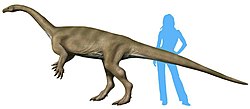Candelária Formation, Paraná Basin
| Candelária Formation | ||
|---|---|---|
Ma | ||
Approximate paleocoordinates 42°24′S 14°42′W / 42.4°S 14.7°W | | |
| Region | Rio Grande do Sul | |
| Country | Brazil | |
| Extent | Paraná Basin | |
| Type section | ||
| Named for | Candelária | |
The Candelária Formation, in other literature also referred to as Candelária Sequence,
The Candelária Formation is composed of
.Description

The Candelária Formation or Sequence corresponds to a third-order sequence placed in the Santa Maria Supersequence. The basal portion of the formation consists of a coarsening-upward succession that begins with red
The red beds are divided into a non-fossiliferous portion at the base, and an upper fossiliferous unit. Coprolites and putative rhizoliths are present. A light-colored cross-bedded sandstone also occurs at the top of the formation and represents a river channel. It is delimited by an erosive contact with the underlying red beds.[5]
The Candelária Formation is considered a local equivalent of the Caturrita Formation,[8] which it partly underlies. It overlies the Santa Maria Formation.[9] The formation is correlated with the Ischigualasto Formation of the Ischigualasto-Villa Unión Basin in northwestern Argentina.[2]
Basin history

The megaregional Paraná Basin, covering an approximate area of 1,500,000 square kilometres (580,000 sq mi) in southeastern South America, was in the late
Fossil content


The formation has provided fossils of
| Group | Fossils | Assemblage zone | Image | Notes |
|---|---|---|---|---|
| Dinosaurs | Erythrovenator jacuiensis | [11] | ||
| Macrocollum itaquii |  |
[12] | ||
| Dinosauria indet. |  |
[13] | ||
| Archosauromorpha indet. | [14] | |||
Therapsids |
Brasilitherium riograndensis |
Riograndia |   |
[2] |
| Brasilodon quadrangularis | Riograndia | [2] | ||
| Botucaraitherium belarminoi | Riograndia | [15] | ||
| Irajatherium hernandezi | Riograndia |  |
[2] | |
| Prozostrodon brasiliensis | Hyperodapedon |  |
[2][16] | |
| Siriusgnathus niemeyerorum | [14] | |||
| Probainognathia indet. | [14] | |||
| Rhynchosaurs | Hyperodapedon sp. | Hyperodapedon |  |
[7][16] |
| Rhynchocephalians | Lanceirosphenodon ferigoloi | Riograndia | [17] |
See also
- List of dinosaur-bearing rock formations
- Chañares Formation, fossiliferous formation of the Ischigualasto-Villa Unión Basin, Argentina
- Santa Juana Formation, contemporaneous fossiliferous formation of south-central Chile
- Molteno Formation, contemporaneous fossiliferous formation of Lesotho and South Africa
- Pebbly Arkose Formation, contemporaneous fossiliferous formation of Botswana, Zambia and Zimbabwe
- Denmark Hill Insect Bed, contemporaneous fossiliferous unit of Queensland, Australia
- Madygen Formation, contemporaneous Lagerstätte of Kyrgyzstan
References
- ^ Müller et al., 2017, p.543
- ^ a b c d e f Botha-Brink, 2018, p.7
- ^ Martinelli et al., 2017, p.528
- ^ a b Candelária Formation at Fossilworks.org
- ^ a b Pretto et al., 2015, p.2
- ^ Soares et al., 2014, p.1675
- ^ a b Pacheco et al., 2017, p.2
- ^ Da Rosa & Faccini, 2005, p.21
- ^ Da Rosa & Faccini, 2005, p.18
- ^ Milani et al., 2007
- ^ Rodrigo T. Müller (2020). "A new theropod dinosaur from a peculiar Late Triassic assemblage of southern Brazil". Journal of South American Earth Sciences. in press: Article 103026. doi:10.1016/j.jsames.2020.103026.
- PMID 30463923.
- ^ Müller et al., 2018, p.545
- ^ a b c Niemeyer, Agudo at Fossilworks.org
- ^ Soares et al., 2014, p.1677
- ^ a b Marchezan at Fossilworks.org
- ^ Romo de Vivar et al., 2020
Bibliography
- Botha-Brink, Jennifer; Marina Bento Soares, and Agustín G. Martinelli. 2018. Osteohistology of Late Triassic prozostrodontian cynodonts from Brazil. PeerJ 5029. 1–26. Accessed 2019-03-25.
- Martinelli, Agustín G.; Marina Bento Soares; Téo Veiga De Oliveira; Pablo G. Rodrigues, and Cesar L. Schultz. 2017. The Triassic eucynodont Candelariodon barberenai revisited and the early diversity of stem prozostrodontians. Acta Palaeontologica Polonica 62. 527–542. Accessed 2019-03-25.
- Milani, E.J.; J.H.G. Melo; P.A. Souza; L.A. Fernandes, and A.B. França. 2007. Bacia do Paraná. Cartas Estratigráficas - Boletim de Geociências da Petrobras, Rio de Janeiro 15. 265–287. .
- Müller, Rodrigo T.; Flávio A. Pretto; Micheli Stefanello; Eduardo Silva Neves, and S. Dias da Silva. 2017. On a dinosaur axis from one of the oldest dinosaur-bearing sites worldwide. Acta Palaeontologica Polonica 62. 543–548. Accessed 2019-03-26.
- Pacheco, C.P.; A.G. Martinelli; A.E.B. Pavanatto; M.B. Soares, and S. Dias da Silva. 2018. Prozostrodon brasiliensis, a probainognathian cynodont from the Late Triassic of Brazil: second record and improvements on its dental anatomy. Historical Biology 30. 475–485. Accessed 2019-03-26.
- Pretto, Flávio A.; Cesar L. Schultz, and Max C. Langer. 2015. New dinosaur remains from the Late Triassic of southern Brazil (Candelária Sequence, Hyperodapedon Assemblage Zone). Alcheringa 39. 1–10. Accessed 2019-03-26.
- Romo de Vivar, Paulo R.; Agustín G. Martinelli; Annie Schmaltz Hsiou, and Marina Bento Soares. 2020. A new rhynchocephalian from the Late Triassic of southern Brazil enhances eusphenodontian diversity.
- Da Rosa, Átila Augusto Stock, and Ubiratan Ferrucio Faccini. 2005. Delimitação de blocos estruturais de diferentes escalas em seqüências mezosóicas do Estado do Rio Grande do Sul: implicações bioestratigraficas. Gaea 1. 16–25. Accessed 2019-03-25.
- Soares, Marina B.; Agustín G. Martinelli, and Téo V. De Oliveira. 2014. A new prozostrodontian cynodont (Therapsida) from the Late Triassic Riograndia Assemblage Zone (Santa Maria Supersequence) of Southern Brazil. Anais da Academia Brasileira de Ciências86. 1673–1691. Accessed 2019-03-26.
Further reading
- Pavanatto, A.E.B.; F.A. Pretto; L. Kerber; R.T.A.S. Müller Da Rosa, and S. Dias da Silva. 2018. A new Upper Triassic cynodont-bearing fossiliferous site from southern Brazil, with taphonomic remarks and description of a new traversodontid taxon. Journal of South American Earth Sciences 88. 179–196. Accessed 2019-03-26.

